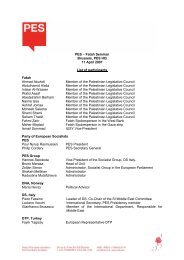Hedge funds and Private Equity - PES
Hedge funds and Private Equity - PES
Hedge funds and Private Equity - PES
Create successful ePaper yourself
Turn your PDF publications into a flip-book with our unique Google optimized e-Paper software.
80<br />
Mortgaging the future to capture gains for personal enrichment in the present is quite an easy<br />
activity. The task for a good manager in a public company is to resist it! Managers have to balance<br />
the interests of today’s shareholders with tomorrow’s shareholders <strong>and</strong> all other stakeholders<br />
including the employees. As seen in so many of our case studies, the one party unrewarded is the<br />
employees. In many cases they suffer an erosion of job security <strong>and</strong> a loss of benefits.<br />
2.13 The societies’ response – current national regulation<br />
The legal, tax <strong>and</strong> operating environment in which a private equity industry may develop is<br />
determined largely at national/local level. Local fiduciary relationships <strong>and</strong> obligations differ<br />
widely in the various Member States. Most Member States regulate part or all of the private<br />
equity value chain. The main areas of regulation cover<br />
Management of <strong>funds</strong><br />
Placement to eligible investors<br />
Tax incentives <strong>and</strong> restrictions<br />
Funds <strong>and</strong> product terms <strong>and</strong> conditions<br />
Those in the industry who have developed specific products for retail consumers comply with a<br />
full range of different regulatory measures enforced by regulators with a strong m<strong>and</strong>ate to<br />
protect retail investors.<br />
As mentioned, the LBO industry would like to see less regulation <strong>and</strong> restrictions. In the EVCA<br />
report 30 , one can see a list of criteria assessing the “friendliness” of the national environment for<br />
<strong>funds</strong>, managers, <strong>and</strong> investors. Among those criteria, the following are to be noted as they<br />
represent at the same time the points where possible regulatory changes would take place:<br />
no additional quantitative restrictions for pension <strong>funds</strong> to invest in private equity or venture<br />
capital on top of IORP directive 2003/41/EC requirements<br />
no geographical conditions for pension <strong>funds</strong> to invest outside EU countries<br />
no additional quantitative restrictions for insurance companies to invest in private equity or<br />
venture capital on top of Insurance Directive 2002/12/EC requirements<br />
no geographical conditions for insurance companies to invest outside EU countries<br />
existence of appropriate fund structure or investment vehicle to be used to invest in private<br />
equity <strong>and</strong> venture capital<br />
tax transparency31 for domestic <strong>and</strong> non-domestic investors<br />
non-domestic investors are exempted from having a permanent establishment in the country<br />
when investing<br />
exemption of VAT on management fees32 exemption of VAT on the carried interest33 no investment restrictions<br />
tax incentives to encourage investment in private equity <strong>and</strong> venture capital<br />
the nominal company tax rate is below the EU average (26.23% including any local <strong>and</strong><br />
municipal taxes <strong>and</strong>/or other charges on income)<br />
there is a special tax rate for SMEs<br />
30 European <strong>Private</strong> <strong>Equity</strong> <strong>and</strong> Venture Capital association <strong>and</strong> KPMG: “Benchmarking Tax <strong>and</strong> legal environments”, Dec 2006.<br />
31 See Glossary<br />
32 Idem<br />
33 Idem




